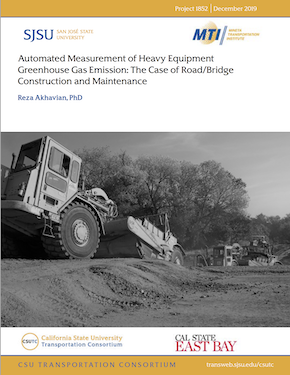- 408-924-7560
- mineta-institute@sjsu.edu
- Donate
Automated Measurement of Heavy Equipment Greenhouse Gas Emission: The Case of Road/Bridge Construction and Maintenance
Road/bridge construction and maintenance projects are major contributors to greenhouse gas (GHG) emissions such as carbon dioxide (CO2), mainly due to extensive use of heavy-duty diesel construction equipment and large-scale earthworks and earthmoving operations. Heavy equipment is a costly resource and its underutilization could result in significant budget overruns. A practical way to cut emissions is to reduce the time equipment spends doing non-value-added activities and/or idling. Recent research into the monitoring of automated equipment using sensors and Internet-of-Things (IoT) frameworks have leveraged machine learning algorithms to predict the behavior of tracked entities.
In this project, end-to-end deep learning models were developed that can learn to accurately classify the activities of construction equipment based on vibration patterns picked up by accelerometers attached to the equipment.
Data was collected from two types of real-world construction equipment, both used extensively in road/bridge construction and maintenance projects: excavators and vibratory rollers. The validation accuracies of the developed models were tested of three different deep learning models: a baseline convolutional neural network (CNN); a hybrid convolutional and recurrent long short-term memory neural network (LSTM); and a temporal convolutional network (TCN). Results indicated that the TCN model had the best performance, the LSTM model had the second-best performance, and the CNN model had the worst performance. The TCN model had over 83% validation accuracy in recognizing activities.
Using deep learning methodologies can significantly increase emission estimation accuracy for heavy equipment and help decision-makers to reliably evaluate the environmental impact of heavy civil and infrastructure projects. Reducing the carbon footprint and fuel use of heavy equipment in road/bridge projects have direct and indirect impacts on health and the economy. Public infrastructure projects can leverage the proposed system to reduce the environmental cost of infrastructure project.
REZA AKHAVIAN, PhD
Dr. Reza Akhavian is an Assistant Professor at the Department of Civil, Construction, and Environmental Engineering at San Diego State University (SDSU) and the Director of the Data-informed Construction Engineering (DiCE) Group. Before that, he was an Assistant Professor of Construction Management at the School of Engineering, California State University East Bay (CSUEB). He received his PhD in Civil Engineering (with Construction Engineering and Management concentration) from the University of Central Florida (UCF). He also holds an M.S. (University of Central Florida, 2012) and a B.S. (University of Tehran, 2010) in Civil Engineering. He has more than 40 articles published in peer-reviewed journals and conference proceedings and serves as a member of the editorial board of the American Society of Civil Engineers (ASCE) Journal of Construction Engineering and Management (JCEM) and Elsevier Journal of Advanced Engineering Informatics. His industry experience includes working with Bentley Systems and DPR Construction and advising construction technology startups. Dr. Akhavian’s research interests are in the areas of information technology, data analytics, machine learning, and automation and robotics for different civil engineering and infrastructure management applications. More specifically, his research and industry involvement focus on leveraging different types of data collected from jobsite entities such as workers, equipment, and material and the built environment to help make informed-decisions. Much current work involves enhancing health, safety, and productivity of construction project operations and sustainability and resiliency of the built environment.
-
Contact Us
San José State University One Washington Square, San Jose, CA 95192 Phone: 408-924-7560 Email: mineta-institute@sjsu.edu






